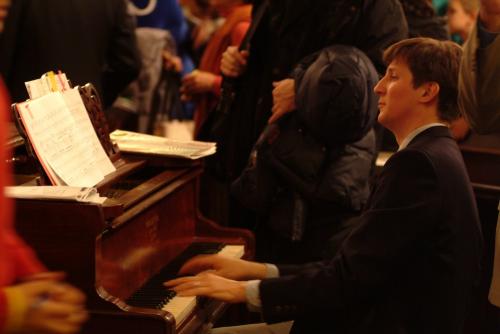
A New York Minute
Student report by Kyle Brooks (M.Div. ‘12)
As the biblical passage goes, one day is as a thousand years to the Creator. One cannot say the same for time on earth. These modern times have produced all manner of timesaving technological advances, but our lives only seem busier, and free time is scarce. Rest and relaxation have been reduced to little more than a pregnant pause before resuming activity at a breakneck speed. A day hardly feels as long as it should.
Imagine, then, setting aside time for restoration amid the hustle of city life. Such is the challenge that faces Second Presbyterian Church in New York City. This Upper West Side congregation has committed itself to creating a time and space to embrace the Sabbath, not only as a day of worship, but also as a concept of rest and freedom. It is a daunting, but necessary task, one that the energetic staff has taken up wholeheartedly.
Founded in 1756, Second Presbyterian Church stands out in part by not standing out at all. Many people walk past it without realizing it is a church. It is nestled in an apartment building adjacent to Central Park West. Leslie Merlin, the pastor, says you practically have to stand across the street and stare at the façade to recognize that it’s a church. It seems fitting that it blends into the surroundings. It is a powerful visual metaphor for the seamless integration of a journey of faith with the daily pursuits of work and play. Indeed, the lives of the parish staff reflect just this sort of blending. Rev. Merlin serves not only as pastor, but also as headmaster for the Alexander Robinson School, the oldest coeducational elementary school in New York City, which was founded by the church in 1789. Paul Sanner, the church’s musical director, is a music teacher there, and Elaine Song, a deacon at the church, is also an editor for a legal publication.
This group of three came to the Congregations Project with the goal of bringing their congregation and community into a Sabbath time of togetherness and joy. In their presentation, Paul mentioned the struggle to “stay alive in the present” and be engaged with what is before them, rather than solely focused on what happens next. As Leslie puts it, their lives (and those of the parishioners) are very scheduled. In all of their coming and going, it is a challenge to find a moment of stillness. Their plan is straightforward: sharing of food, song, and fellowship. Parishioners would rotate duties for each gathering, spreading the load of work and allowing for weeks when people can just come and enjoy themselves with no responsibilities.
Leslie shared how her own family life comes together around the dinner table. When she, her husband, and their children are gathered for an evening meal, something delightful happens. It is as though something about Sabbath, in the intentionality of being with each other, changes everyone involved. This sort of family dynamic is what the staff of Second Presbyterian hopes to bring about in their congregation.
Making this a reality for a parish of around six hundred members is a much different task, though, from making dinner for a single family. Although it is a church-sponsored event, they do not want it to be doctrinal or proselytizing in its intent. It is meant to be a space in which ego can be set aside and community can be embraced. Furthermore, there is the concern for how to bring this vital time to those who are unable to be physically present, whether because of schedules or other obstacles.
Fittingly, it was during our lunchtime gathering that Elaine and I were able to sit and discuss this project in greater depth. At the heart of the Sabbath project helping people reconfigure calendars around what allows them to reflect and feel whole. Elaine echoed the concerns of her two colleagues; this should not be a worship service, but it should still have spiritual importance. We pondered together how this goal might come to fruition, asking a crucial question: what’s our starting point? We found our answer in the words of the Creator spoken to the prophet Jeremiah: by lovingkindness have I drawn thee. What Second Presbyterian is offering is an invitation, an open-ended welcome. And when people are welcomed, there is no need to “control” the experience. Rather, there is an opportunity for the church and its members to be themselves. It is an opportunity to realize that when people feel cared for, they respond.
Perhaps, then, the way forward is to bring together the basic elements, to offer the call and await the response. The best-laid plans often do not go just as we expect, but is that always such a bad thing? It could be that the soul-stirring need for a transformative Sabbath experience is lying dormant in people’s hearts and merely waiting for a place to break forth. Second Presbyterian Church is laying the groundwork for a constructive way of putting time in service of its parish, instead of the other way around. It has the potential to produce a deeper, expansive joy through communal connection. In a city of small apartments, cramped schedules, and high stress, a creative approach to Sabbath might be just the way to slow down the day and realize a peace and quietness that lasts longer than a New York minute.